10 Types of Marine Reptiles of the Mesozoic Era


Written and verified by the biologist Cesar Paul Gonzalez Gonzalez
Reptiles were the most successful group during the Mesozoic Era (more than 250 million years ago). In fact, they came to populate every existing habitat. At that time, large land movements caused the continent to divide and caused them to diversify even more. Because of this, some marine reptiles came to reach the size and shape of dinosaurs.
In this article, we’ll explore these extinct giants of the ocean that look like dinosaurs but don’t formally belong to this group. If you want to know more about them, keep reading the following article and be amazed!
The colonization of land and diversification
Life has its origin in water, so living beings became dependent on it. For this reason, in order to colonize dry land, they needed to find a way to reproduce without needing water. Thus, reptiles and mammals were the groups that managed to break this barrier through the development of two strategies: Eggs and a placenta.
Although it sounds simple, in reality, this process took millions of years and only eliminated the immediate need for water, because, in essence, they continued to make use of it. However, it was enough for one of them to take over the reign of the earth, conquering and dominating it.
In the end, thanks to this, reptiles managed to diversify, and new species appeared. But soon, all this would cause the organisms to start fighting, and competition for resources would become a factor.
Reptiles to the water
An article published in the journal Proceedings of the Royal Society B: Biological Sciences suggests that several reptiles decided to return to the aquatic environment after the mass extinction that occurred at the end of the Permian period. About 252 million years ago, this event gave way to a new ecosystem.
These creatures managed to reach enormous sizes, almost dinosaur-like. Very interesting research reported in the journal Nature Ecology & Evolution states that these marine reptiles played ecological roles now dominated by the following animals:
- Cetaceans
- Sharks
- Crocodiles
- Large fish
In addition, many groups coexisted for more than 50 million years.
What’s the difference between dinosaurs and reptiles?
Although it seems minimal, the big difference between dinosaurs of the past and today’s reptiles lies in the position of the limbs. Simply put, dinosaurs have their legs placed under their body, while reptiles have them on the sides.
Among dinosaurs, there’s another more specific classification related to the orientation of their hip bone (pubis). In this regard, the distinction is as follows:
- Saurischia: The pubis is oriented forward. This group is also known as lizard-hipped dinosaurs and includes theropods (Tyrannosaurus rex), sauropods (Diplodocus), as well as segnosaurs (Enigmosaurus).
- Ornithischians: The pubis is located backward, and they’re also called bird-hipped. The group consisted of thyreophorans(Stegosaurus), marginocephalans (Triceratops), and ornithopods (Hadrosaurus).
Why are they called marine reptiles and not marine dinosaurs?
The answer lies in the shape of their legs, as their limbs are inserted laterally, i.e., like any other reptile. When observing the plesiosaur, it’s possible to observe that its fins are next to the body. This characteristic of their morphology made them better swimmers. For this reason, these species may look like dinosaurs, but they’re not.
Marine reptiles of the Mesozoic era
Marine reptiles are no slouches in terms of their size and ferocity. In view of this, they’ve often been mistaken for dinosaurs. Here’s a compilation of these giants of the waters from the Mesozoic era:
1. Mesosaurs
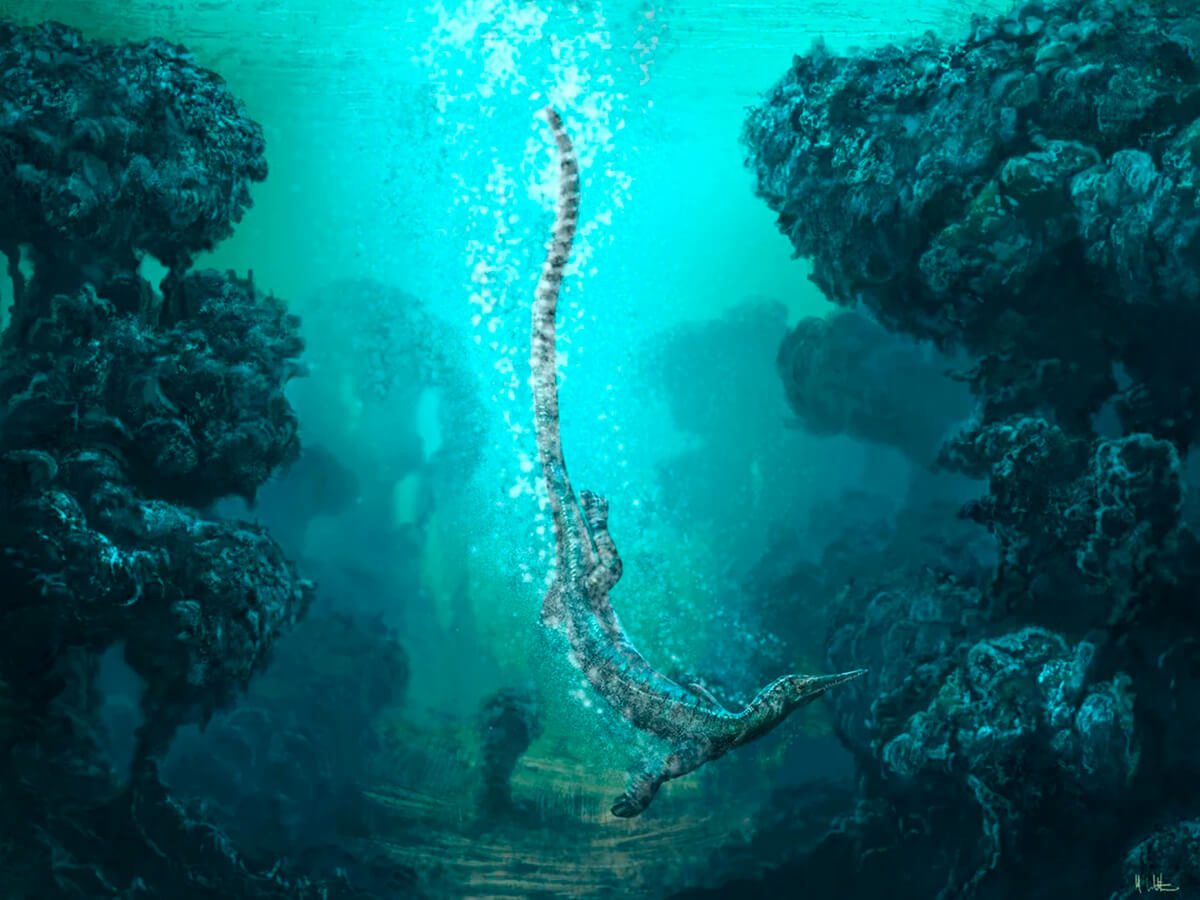
This is one of the oldest known reptiles, and it was barely three feet long. The mesosaur inhabited the planet several million years before the dinosaurs appeared and is even considered the ancestor of the ichthyosaurs. Thanks to this reptile, the hypothesis of the supercontinent Pangaea was formulated.
A publication published in the journal Frontiers warns that the mesosaur could have been a semi-aquatic animal after reaching a considerable size and age. This is suggested by the profiles of the vertebrae of the fossils found.
1. Mosasaurs
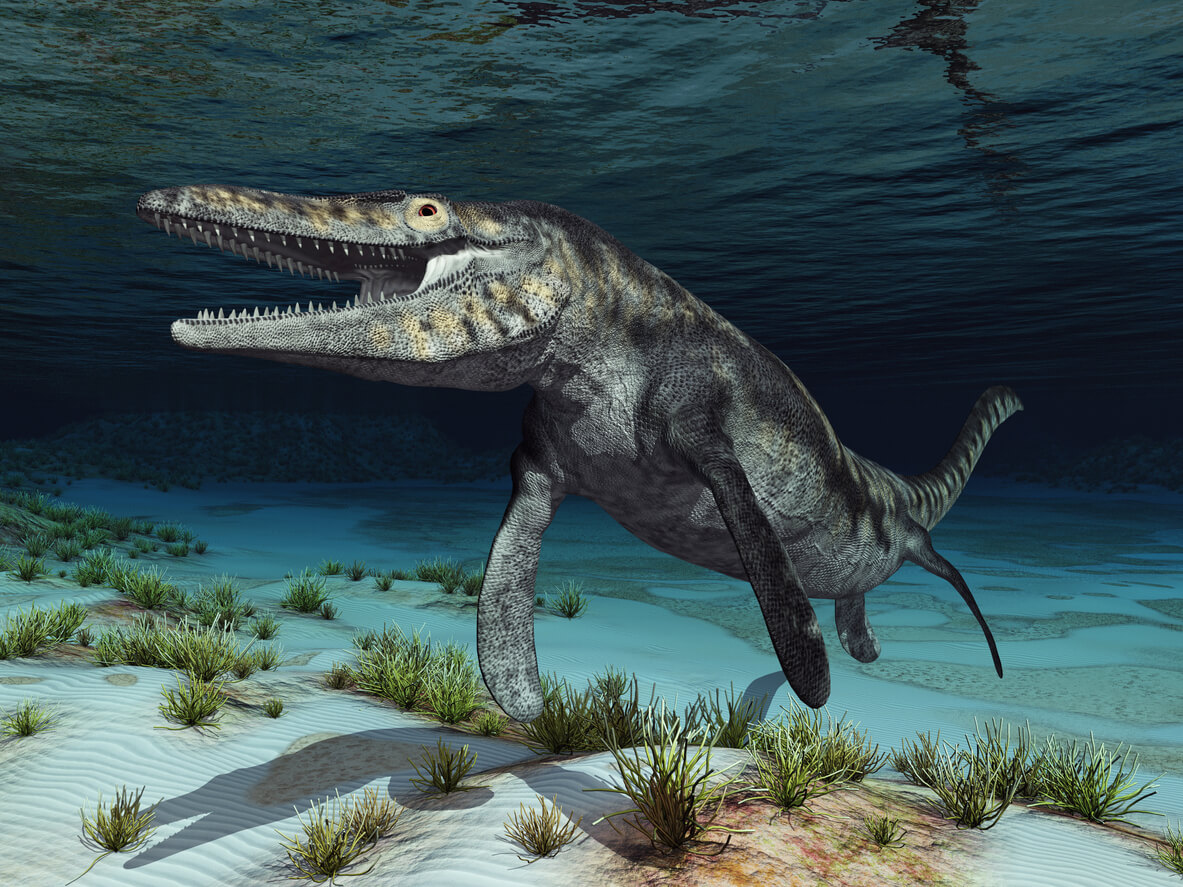
They were a group of predators with huge tails, which fed thanks to their large jaws and ferocious teeth. Their shape somewhat resembles that of a snake or an eel, so their movements were serpentine.
3. Sea turtles
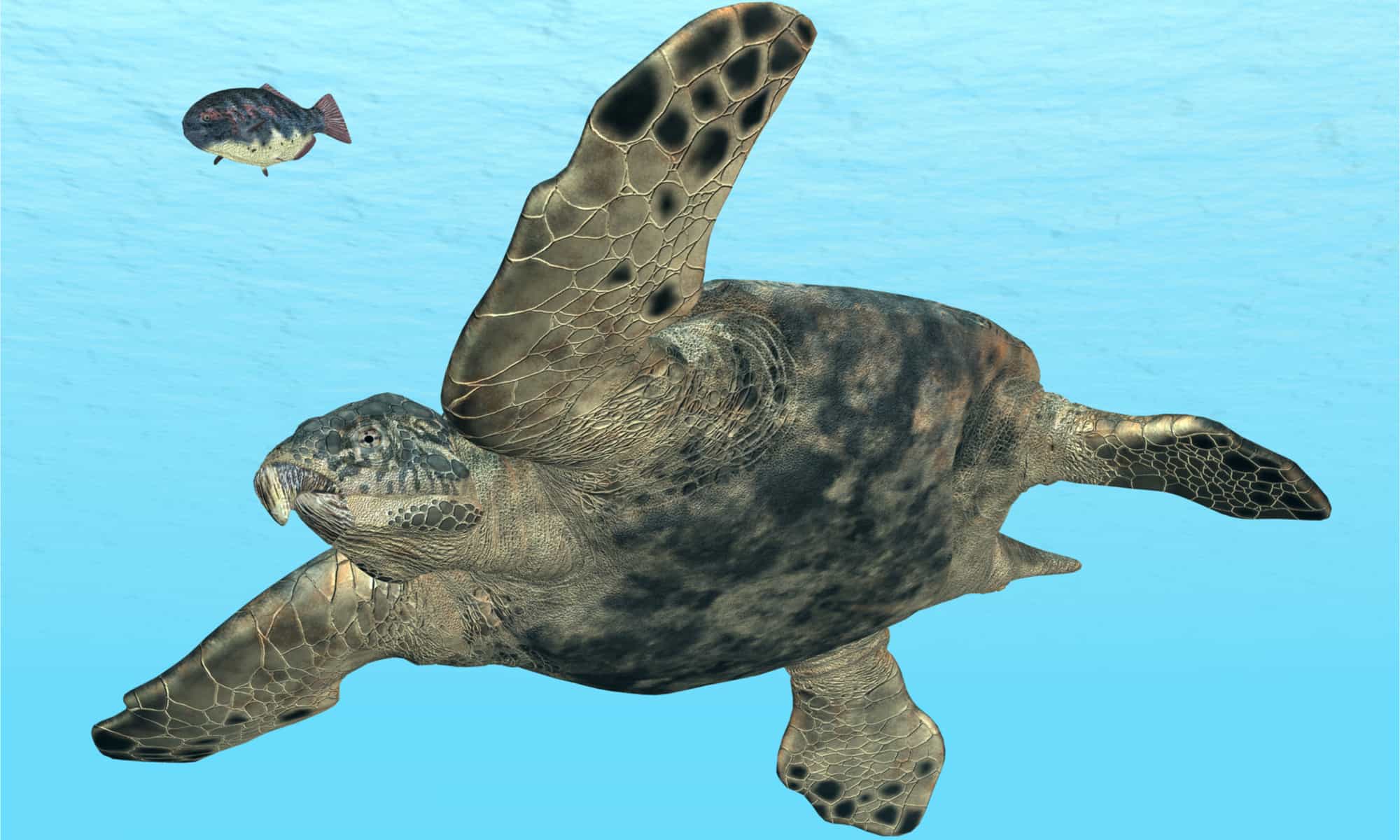
A close relative of today’s turtles, it’s one of the oldest species ever found. It was characterized by a huge carapace, reaching 13 to 16 feet in length.
Some of the preserved fossils of the genus Megalochelys reach 6.5 feet in carapace length, but they’re of species believed to be juveniles. It was one of the few types of sea turtles, which is believed to have lived alongside dinosaurs.
4. Pliosaurs
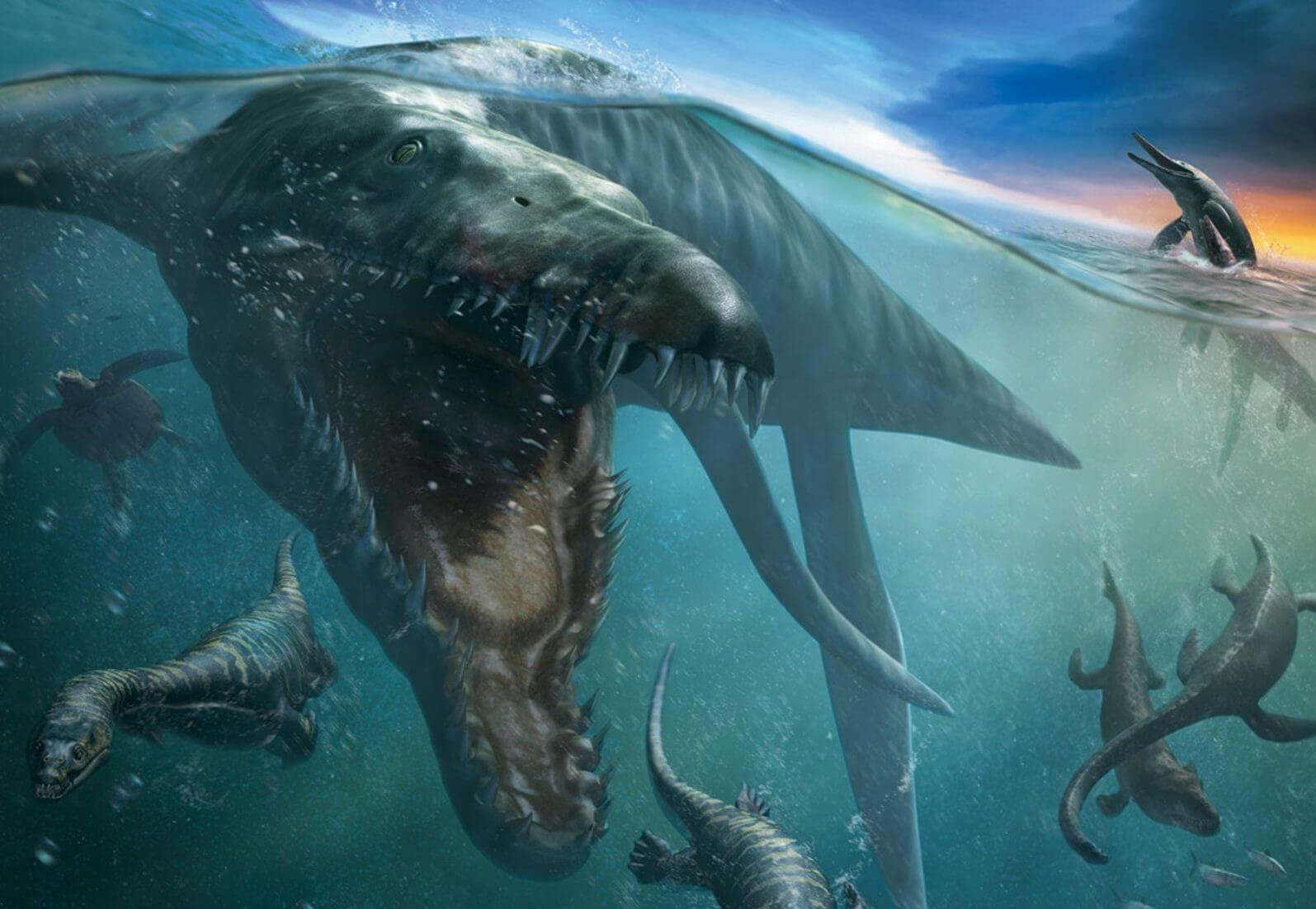
Also known as the closest to the lizard, it was a triangular-toothed carnivore from the Jurassic and Early Cretaceous periods. Its head bore a close resemblance to that of crocodiles, but its body was more similar to that of a whale.
5. Thalatosaurus
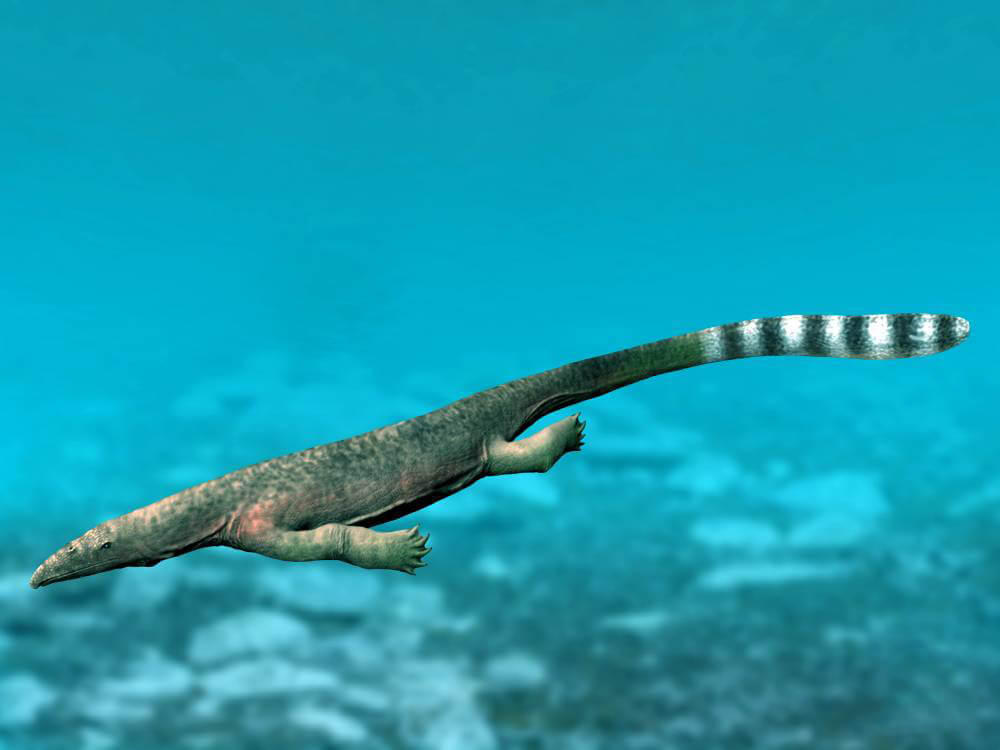
These were flat-shaped reptiles with a fairly flexible body. Their nose and tail were the most elongated parts, but they also made up the most efficient sections of their physique. Their teeth could be capable of breaking shells and bones. Because of this, they were fearsome predators.
6. Plesiosaurs
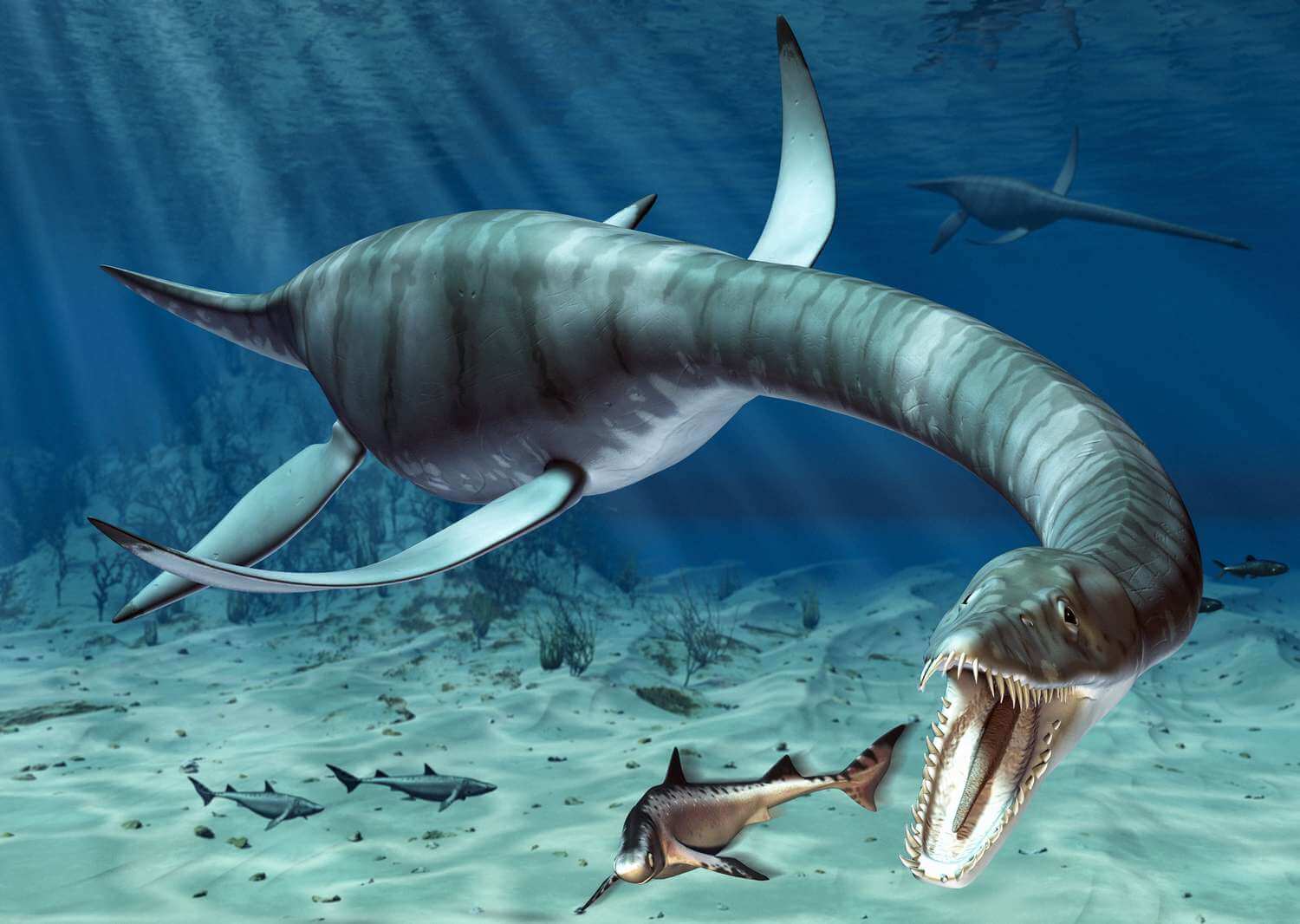
Considered one of the best-known marine reptiles, it’s also one of the largest. It was characterized by having a neck that was quite long and a head that was a bit small in regard to its body. In addition, it’s believed that it used its four lateral limbs as oars in order to move quickly and efficiently.
The myth of the Loch Ness Monster is believed to be based on this creature.
7. Ichthyosaurs
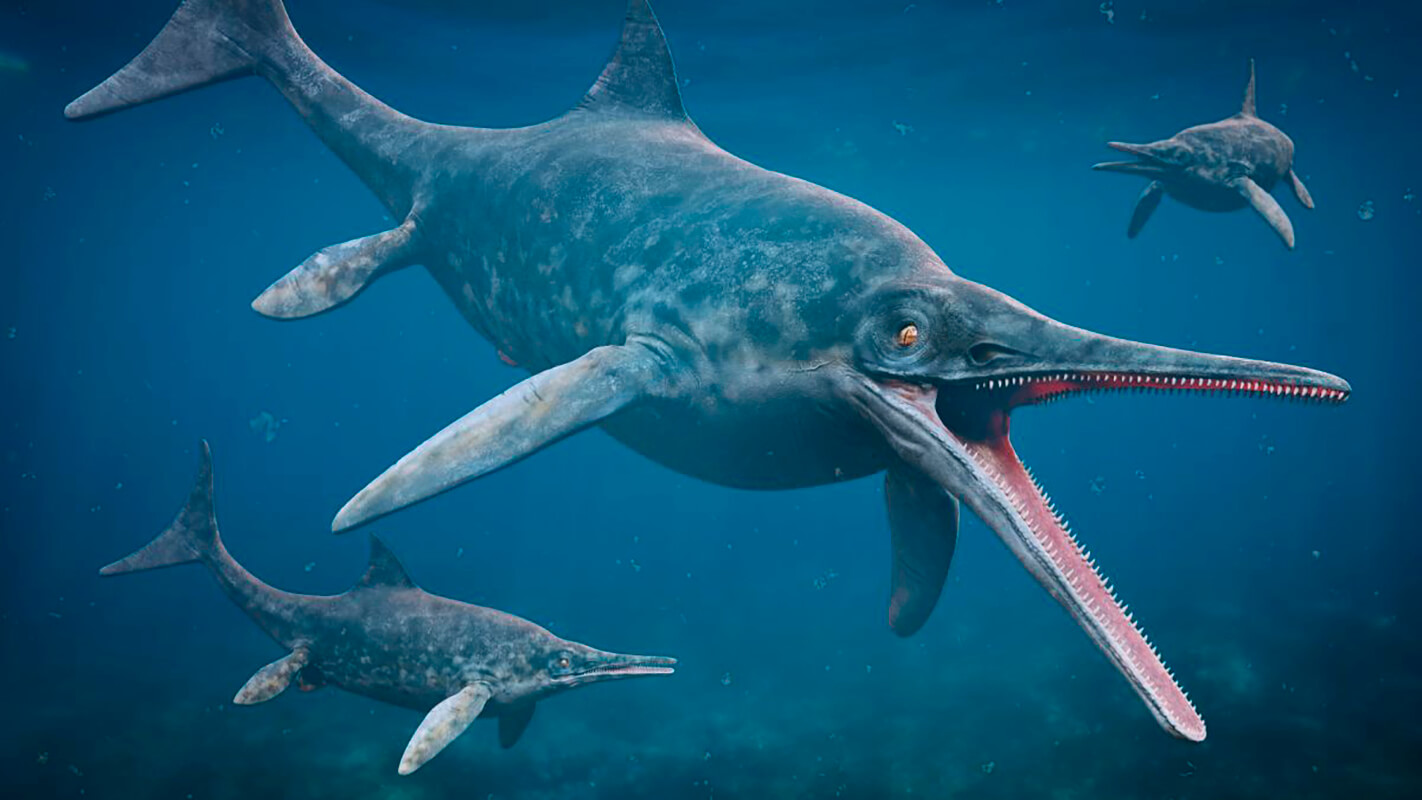
Their body appears to be a fusion between a reptile and a dolphin, although they’re in no way related to the latter. The main strength that allowed them to swim came from their tail, so their other fins functioned as stabilizers.
It’s estimated that this marine reptile reached 10 feet in length.
8. Placodonts
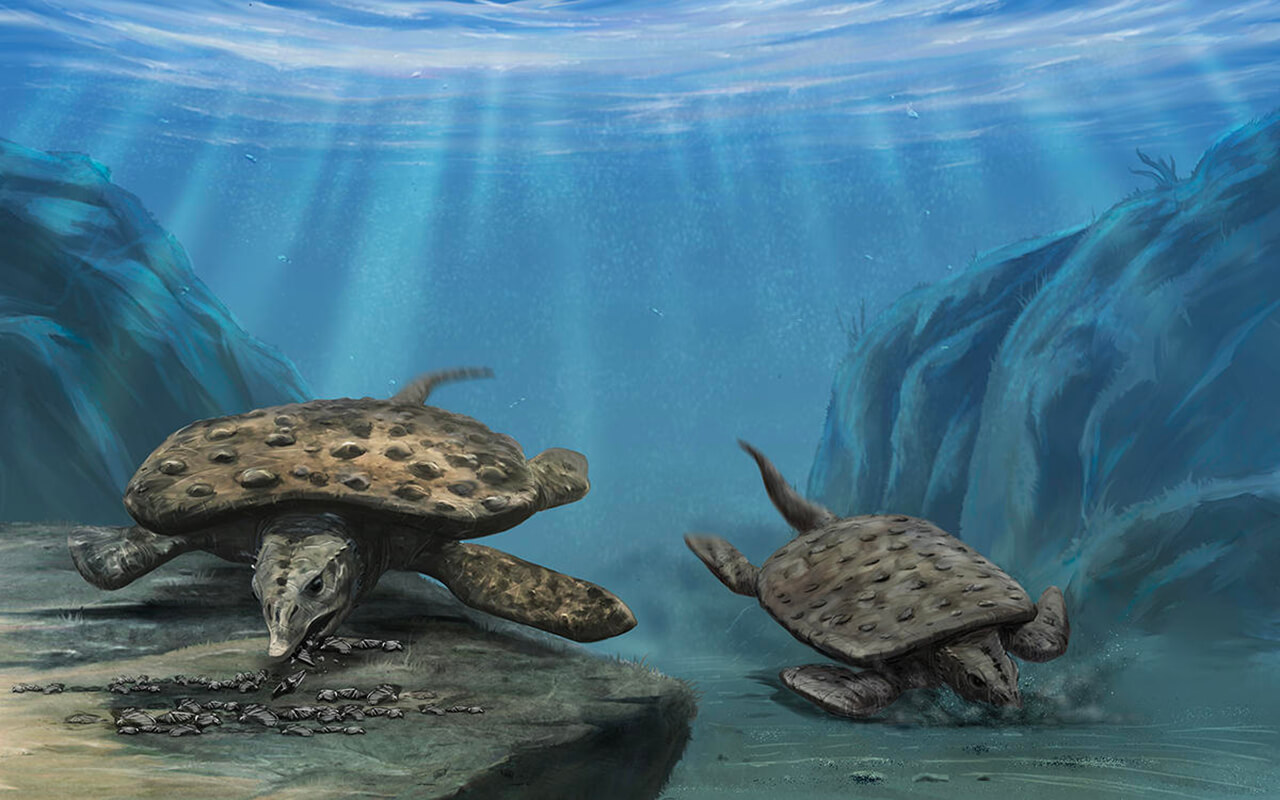
These reptiles were very similar to turtles in that they had hard shells for defense. Although they have similar characteristics, turtles and placodonts aren’t directly related, so both are considered to have developed this formidable defense on their own.
Its main characteristics were the flat teeth in its jaw, from which it derives its name.
6. Notosaurs

These marine reptiles shared the water with the ichthyosaurs. Unlike the latter, they didn’t have flattened bodies. In addition, their limbs were broad, like those of a terrestrial species, so their movements must have been more like those of a dog when swimming. However, their teeth were very sharp, as this species could pierce the flesh of their prey with great ease.
10. Gallardosaurs
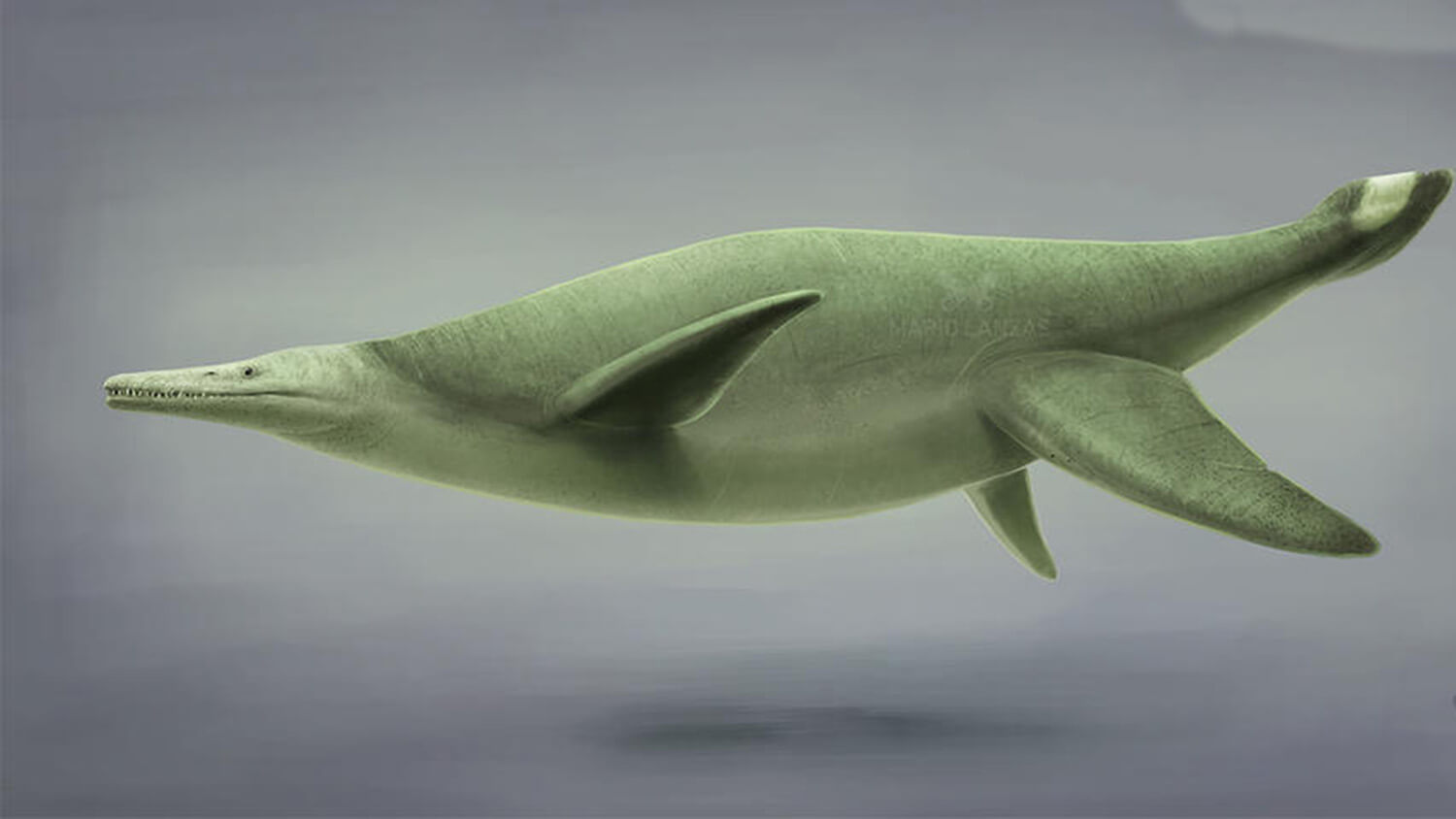
This animal was considered one of the top predators of the sea. Its large size and sharp teeth allowed it to pierce and break bones. The Gallardosaurus iturraldei was an inhabitant of the ancient Caribbean Sea and was described in 2009 by Argentine paleontologist Zulma Gasparini.
Why did dinosaurs and marine reptiles become extinct?
One of the most accepted theories that explain the extinction of the Mesozoic era is that of a meteorite impact, as detailed in an article in Desde El Herbario CICY. This hypothesis tells us that the impact produced on the Earth caused an endless number of atmospheric changes, which put an end to a great part of life on Earth.
This included the dinosaurs, as even if they could survive the impact, the lack of resources would eventually destroy them.
Although this explanation is supported by several evidences, some specialists consider that this is only a part of the truth. Because of this, it’s presumed that there were other events, just as devastating, that began to eradicate life. In this way, the meteorite would only have finished the job, something like the icing on the cake.
In this regard, some specialists think that this extinction had its origin in a process of climate change. This is because, at that time, volcanic activity was higher, so many gases were released into the air. In addition, the continents were in motion, causing habitats to change or disappear.
Both events caused a slow change in climate stability, which caused a similar case to global warming.
This is important, as many species were unable to adapt to these transformations and would eventually become extinct. Thus, the meteorite only aggravated the situation and caused the end of the age of dinosaurs and reptiles.
Traces of prehistoric marine reptiles
Reptiles have been one of the most important groups in history, so much so that they dominated for millions of years. Although many of them disappeared, there are still traces of their existence, which tell us a little about the situation they lived in. Whether on land or in water, it’s thanks to fossils that we can reconstruct a bit of history and learn about these magnificent species lost in time.
Reptiles were the most successful group during the Mesozoic Era (more than 250 million years ago). In fact, they came to populate every existing habitat. At that time, large land movements caused the continent to divide and caused them to diversify even more. Because of this, some marine reptiles came to reach the size and shape of dinosaurs.
In this article, we’ll explore these extinct giants of the ocean that look like dinosaurs but don’t formally belong to this group. If you want to know more about them, keep reading the following article and be amazed!
The colonization of land and diversification
Life has its origin in water, so living beings became dependent on it. For this reason, in order to colonize dry land, they needed to find a way to reproduce without needing water. Thus, reptiles and mammals were the groups that managed to break this barrier through the development of two strategies: Eggs and a placenta.
Although it sounds simple, in reality, this process took millions of years and only eliminated the immediate need for water, because, in essence, they continued to make use of it. However, it was enough for one of them to take over the reign of the earth, conquering and dominating it.
In the end, thanks to this, reptiles managed to diversify, and new species appeared. But soon, all this would cause the organisms to start fighting, and competition for resources would become a factor.
Reptiles to the water
An article published in the journal Proceedings of the Royal Society B: Biological Sciences suggests that several reptiles decided to return to the aquatic environment after the mass extinction that occurred at the end of the Permian period. About 252 million years ago, this event gave way to a new ecosystem.
These creatures managed to reach enormous sizes, almost dinosaur-like. Very interesting research reported in the journal Nature Ecology & Evolution states that these marine reptiles played ecological roles now dominated by the following animals:
- Cetaceans
- Sharks
- Crocodiles
- Large fish
In addition, many groups coexisted for more than 50 million years.
What’s the difference between dinosaurs and reptiles?
Although it seems minimal, the big difference between dinosaurs of the past and today’s reptiles lies in the position of the limbs. Simply put, dinosaurs have their legs placed under their body, while reptiles have them on the sides.
Among dinosaurs, there’s another more specific classification related to the orientation of their hip bone (pubis). In this regard, the distinction is as follows:
- Saurischia: The pubis is oriented forward. This group is also known as lizard-hipped dinosaurs and includes theropods (Tyrannosaurus rex), sauropods (Diplodocus), as well as segnosaurs (Enigmosaurus).
- Ornithischians: The pubis is located backward, and they’re also called bird-hipped. The group consisted of thyreophorans(Stegosaurus), marginocephalans (Triceratops), and ornithopods (Hadrosaurus).
Why are they called marine reptiles and not marine dinosaurs?
The answer lies in the shape of their legs, as their limbs are inserted laterally, i.e., like any other reptile. When observing the plesiosaur, it’s possible to observe that its fins are next to the body. This characteristic of their morphology made them better swimmers. For this reason, these species may look like dinosaurs, but they’re not.
Marine reptiles of the Mesozoic era
Marine reptiles are no slouches in terms of their size and ferocity. In view of this, they’ve often been mistaken for dinosaurs. Here’s a compilation of these giants of the waters from the Mesozoic era:
1. Mesosaurs

This is one of the oldest known reptiles, and it was barely three feet long. The mesosaur inhabited the planet several million years before the dinosaurs appeared and is even considered the ancestor of the ichthyosaurs. Thanks to this reptile, the hypothesis of the supercontinent Pangaea was formulated.
A publication published in the journal Frontiers warns that the mesosaur could have been a semi-aquatic animal after reaching a considerable size and age. This is suggested by the profiles of the vertebrae of the fossils found.
1. Mosasaurs

They were a group of predators with huge tails, which fed thanks to their large jaws and ferocious teeth. Their shape somewhat resembles that of a snake or an eel, so their movements were serpentine.
3. Sea turtles

A close relative of today’s turtles, it’s one of the oldest species ever found. It was characterized by a huge carapace, reaching 13 to 16 feet in length.
Some of the preserved fossils of the genus Megalochelys reach 6.5 feet in carapace length, but they’re of species believed to be juveniles. It was one of the few types of sea turtles, which is believed to have lived alongside dinosaurs.
4. Pliosaurs

Also known as the closest to the lizard, it was a triangular-toothed carnivore from the Jurassic and Early Cretaceous periods. Its head bore a close resemblance to that of crocodiles, but its body was more similar to that of a whale.
5. Thalatosaurus

These were flat-shaped reptiles with a fairly flexible body. Their nose and tail were the most elongated parts, but they also made up the most efficient sections of their physique. Their teeth could be capable of breaking shells and bones. Because of this, they were fearsome predators.
6. Plesiosaurs

Considered one of the best-known marine reptiles, it’s also one of the largest. It was characterized by having a neck that was quite long and a head that was a bit small in regard to its body. In addition, it’s believed that it used its four lateral limbs as oars in order to move quickly and efficiently.
The myth of the Loch Ness Monster is believed to be based on this creature.
7. Ichthyosaurs

Their body appears to be a fusion between a reptile and a dolphin, although they’re in no way related to the latter. The main strength that allowed them to swim came from their tail, so their other fins functioned as stabilizers.
It’s estimated that this marine reptile reached 10 feet in length.
8. Placodonts

These reptiles were very similar to turtles in that they had hard shells for defense. Although they have similar characteristics, turtles and placodonts aren’t directly related, so both are considered to have developed this formidable defense on their own.
Its main characteristics were the flat teeth in its jaw, from which it derives its name.
6. Notosaurs

These marine reptiles shared the water with the ichthyosaurs. Unlike the latter, they didn’t have flattened bodies. In addition, their limbs were broad, like those of a terrestrial species, so their movements must have been more like those of a dog when swimming. However, their teeth were very sharp, as this species could pierce the flesh of their prey with great ease.
10. Gallardosaurs

This animal was considered one of the top predators of the sea. Its large size and sharp teeth allowed it to pierce and break bones. The Gallardosaurus iturraldei was an inhabitant of the ancient Caribbean Sea and was described in 2009 by Argentine paleontologist Zulma Gasparini.
Why did dinosaurs and marine reptiles become extinct?
One of the most accepted theories that explain the extinction of the Mesozoic era is that of a meteorite impact, as detailed in an article in Desde El Herbario CICY. This hypothesis tells us that the impact produced on the Earth caused an endless number of atmospheric changes, which put an end to a great part of life on Earth.
This included the dinosaurs, as even if they could survive the impact, the lack of resources would eventually destroy them.
Although this explanation is supported by several evidences, some specialists consider that this is only a part of the truth. Because of this, it’s presumed that there were other events, just as devastating, that began to eradicate life. In this way, the meteorite would only have finished the job, something like the icing on the cake.
In this regard, some specialists think that this extinction had its origin in a process of climate change. This is because, at that time, volcanic activity was higher, so many gases were released into the air. In addition, the continents were in motion, causing habitats to change or disappear.
Both events caused a slow change in climate stability, which caused a similar case to global warming.
This is important, as many species were unable to adapt to these transformations and would eventually become extinct. Thus, the meteorite only aggravated the situation and caused the end of the age of dinosaurs and reptiles.
Traces of prehistoric marine reptiles
Reptiles have been one of the most important groups in history, so much so that they dominated for millions of years. Although many of them disappeared, there are still traces of their existence, which tell us a little about the situation they lived in. Whether on land or in water, it’s thanks to fossils that we can reconstruct a bit of history and learn about these magnificent species lost in time.
All cited sources were thoroughly reviewed by our team to ensure their quality, reliability, currency, and validity. The bibliography of this article was considered reliable and of academic or scientific accuracy.
- Bardet, N., Falconnet, J., Fischer, V., Houssaye, A., Jouve, S., Suberbiola, X., Pérez-García, A., Rage, J., & Vincent, P. (2014). Mesozoic marine reptile palaeobiogeography in response to drifting plates. Gondwana Research, 26(3-4), 869-887. https://www.sciencedirect.com/science/article/abs/pii/S1342937X1400183X
- de Miguel, C. (2018). Historia evolutiva de Simosauridae (Sauropterygia). [Tesis Doctoral] UNED. Universidad Nacional de Educación a Distancia. https://portalcientifico.uned.es/documentos/5f63fc8d29995274fc8e8dbb
- Foffa, D., Young, M. T., Stubbs, T. L., Dexter, K. G., & Brusatte, S. L. (2018). The long-term ecology and evolution of marine reptiles in a Jurassic seaway. Nature Ecology & Evolution, 2(10), 1548-1555. https://www.nature.com/articles/s41559-018-0656-6
- Gasparini, Z. (2009). A new Oxfordian pliosaurid (Plesiosauria, Pliosauridae) in the Caribbean Seaway. Palaeontology, 52(3):661-669. https://onlinelibrary.wiley.com/doi/full/10.1111/j.1475-4983.2009.00871.x
- González , P. (2017). Los mosasaurios (Reptilia; Squamata) de la Formación López de Bertodano (Maastrictiano tardío, Cretácico tardío) de la Isla Marambio, Cuenca James Roos (Antártida). [Tesis Doctoral]. Universidad de Buenos Aires. https://bibliotecadigital.exactas.uba.ar/download/seminario/seminario_nPAL000040_GonzalezRuiz.pdf
- Hirayama, R., Sonoda, T., Takai, M., Htike, T., Thein, Z., & Takahashi, A. (2015). Megalochelys: gigantic tortoise from the Neogene of Myanmar. PeerJ PrePrints. https://peerj.com/preprints/961v1/
- Iturralde-Vinent, M., & Gasparini, Z. (2013). Animales del Caribe primitivo y sus costas. Editorial Oriente.
- Lara, S. (2019). Una ventana al fin del mundo de los dinosaurios. Desde El Herbario CICY, 11, 91–97, 2019. https://cicy.repositorioinstitucional.mx/jspui/handle/1003/2539
- Motani, R., Jiang, D. Y., Tintori, A., Ji, C., & Huang, J. D. (2017). Pre-versus post-mass extinction divergence of Mesozoic marine reptiles dictated by time-scale dependence of evolutionary rates. Proceedings of the Royal Society B: Biological Sciences, 284(1854), 20170241. https://royalsocietypublishing.org/doi/10.1098/rspb.2017.0241
- Nuñez, P., Meneghel, M., Laurin, M., & Piñeiro, G. (2018). Was Mesosaurus a fully aquatic reptile?. Frontiers in Ecology and Evolution, 6, 109. https://www.frontiersin.org/articles/10.3389/fevo.2018.00109/full
- Otero, R., Rubilar-Rogers, D., & Gutstein, C. (2015). Un nuevo mosasaurio (Squamata, Mosasauroidea) del Cretácico Superior de Antártica. XIV Congreso Geológico Chileno. https://www.researchgate.net/publication/282586503_Un_nuevo_mosasaurio_Squamata_Mosasauroidea_del_Cretacico_Superior_de_Antartica
- Riquelme, R. (2020). El «Evento Pluvial del Carniense» (Triásico Superior). Cambio climático, extinción asociada y posterior diversificación de los dinosaurios. [Tesis de Grado]. Universidad de Alicante. Departamento de Ciencias de la Tierra y del Medio Ambiente. https://rua.ua.es/dspace/handle/10045/108387
This text is provided for informational purposes only and does not replace consultation with a professional. If in doubt, consult your specialist.








